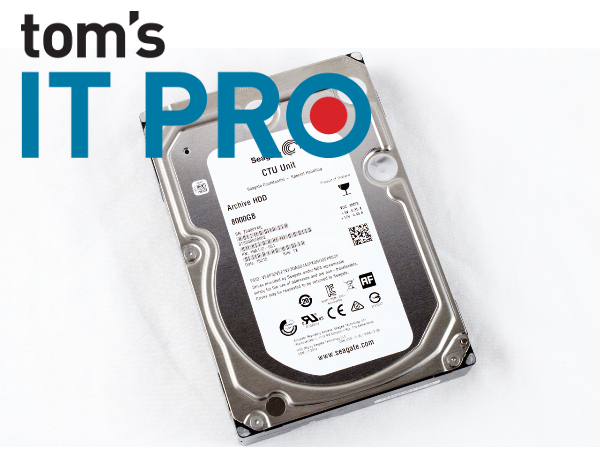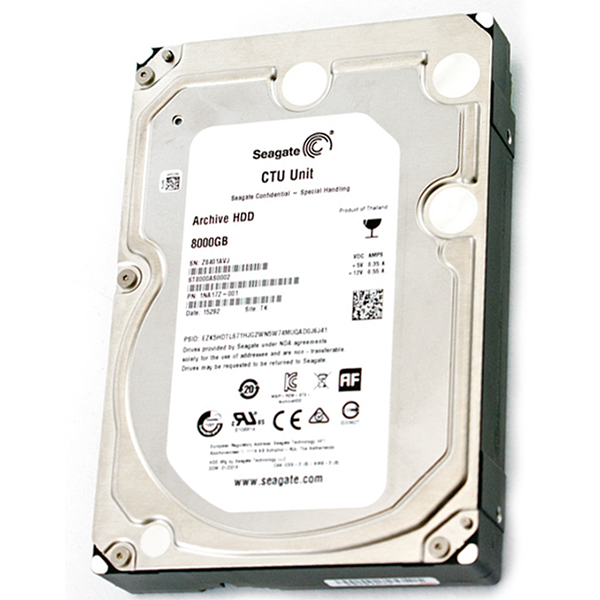Seagate 8TB Archive HDD Review
We create more data every time we snap a picture with our phone, record a video or post something to a social media website. The budding Internet of Things (IoT) means that our thermostats, vehicles and toasters (conceivably) only add to this unending stream of data. The Internet reaches to the far flung corners of the globe and the number of users streaming data, seemingly just into the nether, continues to expand every day.
The only problem is that the data isn't actually disappearing into the nether. We expect to be able to retrieve a family picture in mere milliseconds from Facebook even if we uploaded it (and forgot about it) five years ago. We increasingly (and blindly) trust that our social media services will safely store our data and memories, well, forever.
The picture from your latest snap has to land somewhere, and that "somewhere" is a server that churns away day and night. This influx of data creates a tremendous challenge at the other end of the pipe, and datacenter operators are tasked with keeping this exponentially increasing burden of data under safe keeping; but the key is to do it in a cost-effective manner.
HDD vendors have responded to the need for more storage with clever engineering that increases the amount of storage they can provide per device, as well as per dollar. The newest innovation comes in the form of SMR (Shingled Magnetic Recording), which overlays data tracks to increase the amount of available storage capacity.
The Seagate SMR datacenter offering lowers cost to an unheard-of three cents per gigabyte of storage (and that is at retail pricing). This low cost has made the drives increasingly popular with consumers for bulk data storage, which is a use-case the drive excels at.
However, SMR is not without its tradeoffs. For those who aren't familiar with the limitations of SMR technology it can become a frustrating experience. Never fear, we've got it all figured out. Come along as we explore all things SMR in our Seagate 8TB Archive HDD Review at Tom's IT Pro.
MORE: How We Test Enterprise HDDs
MORE: SMR (Shingled Magnetic Recording) 101
Get Tom's Hardware's best news and in-depth reviews, straight to your inbox.
Paul Alcorn is a Contributing Editor for Tom's IT Pro, covering Storage. Follow him on Twitter and on Google+.
Follow Tom's IT Pro on Twitter, Facebook, LinkedIn and Google+.

Paul Alcorn is the Editor-in-Chief for Tom's Hardware US. He also writes news and reviews on CPUs, storage, and enterprise hardware.
-
Wow, 8TB for about $250, seems great! I've used SMR drives. They are awesome if you write few/ read many. Also if your writes aren't that massive. But if you write a lot, after a while things crawl from 200 MB/s to 30 MB/s, and the head starts to move around every so many seconds from the buffer to a shingle and back.Reply
In a couple of years, SSD's will come with 10TB+, but meanwhile this is a very good deal.
Also, power loss can lead to corrupted sectors with SMR, so you have to be more careful.
Five of these in raid-6 give 24 TB of storage space, very awesome. -
Paul Alcorn ReplyWow, 8TB for about $250, seems great! I've used SMR drives. They are awesome if you write few/ read many. Also if your writes aren't that massive. But if you write a lot, after a while things crawl from 200 MB/s to 30 MB/s, and the head starts to move around every so many seconds from the buffer to a shingle and back.
In a couple of years, SSD's will come with 10TB+, but meanwhile this is a very good deal.
Also, power loss can lead to corrupted sectors with SMR, so you have to be more careful.
Five of these in raid-6 give 24 TB of storage space, very awesome.
Actually, Seagate uses a section of the platter to back up the volatile cache, so these drives are less likely to experience data loss than a typical desktop HDD. -
Reply
Wow, 8TB for about $250, seems great! I've used SMR drives. They are awesome if you write few/ read many. Also if your writes aren't that massive. But if you write a lot, after a while things crawl from 200 MB/s to 30 MB/s, and the head starts to move around every so many seconds from the buffer to a shingle and back.
In a couple of years, SSD's will come with 10TB+, but meanwhile this is a very good deal.
Also, power loss can lead to corrupted sectors with SMR, so you have to be more careful.
Five of these in raid-6 give 24 TB of storage space, very awesome.
Actually, Seagate uses a section of the platter to back up the volatile cache, so these drives are less likely to experience data loss than a typical desktop HDD.
Yeah, except I've experienced it. It happens when data is being transferred from the buffer (on the drive, that buffer track) to a shingled area and you get a power loss. It shows up as corrupted sectors, but they aren't. After you use the drive for a while, the corrupted sectors drop back to 0.
From some engineers:
1) A power loss when running with write cache enabled (i.e. normally - see hdparm for description) it can get a full track (~2MB or 500 sectors) of bad sectors - the old data was damaged when the overlapping track was written, but new data hasn't been written yet. Those sectors will stay bad until you re-write them with valid data.
2) I've heard from the guy we work with at Seagate that they were worried about how long the startup code could take under certain failure recovery situations, risking drive timeouts like the one you saw. -
Paul Alcorn To my understanding the data is still held in the cache section of the platter until it is committed to the new band in the home location. this is why the sectors show up temporarily as corrupted, they corrupted sectors are in the home location. However, a copy of the data still exists in the media cache, and during idle time, or when the drive basically gets around to it, it will re-write the effected band, copying the valid data back from the media cache, thus 'repairing' the corrupted sectors. Did you experience permanent data loss, or just temporarily? Of course, things don't always happen as they 'should' in real life.Reply -
Reply
To my understanding the data is still held in the cache section of the platter until it is committed to the new band in the home location. this is why the sectors show up temporarily as corrupted, they corrupted sectors are in the home location. However, a copy of the data still exists in the media cache, and during idle time, or when the drive basically gets around to it, it will re-write the effected band, copying the valid data back from the media cache, thus 'repairing' the corrupted sectors. Did you experience permanent data loss, or just temporarily? Of course, things don't always happen as they 'should' in real life.
In my case, it was permanent. 4728 sectors were flagged as bad, on a 5TB model. Eventually, the sectors were reclassified as ok, but the data loss and corruption was permanent. I have overall data redundancy and checksums, so I didn't actually lose any data overall because of this.
The drive is marketed as "Archive HDD", and in that context, it's excellent. Most people don't write that much non-sequential data for extended periods of time. For most consumer use, this drive is a very good choice.
The persistent cache is about 20-25 GB, so actually, you can write relatively a lot of random data without any performance degradation. -
MidnightDistort And just when you think they couldn't do more than 5TB they do an 8TB, pretty impressive.Reply -
JPNpower ReplyAnd just when you think they couldn't do more than 5TB they do an 8TB, pretty impressive.
Remember, this is "kinda gotcha" 8TB. Not the real deal. Only through sketchy SMR or witchcraft helium. -
billyboy999 Interesting - from the article: Seagate does not recommended utilizing these drives in RAID or NAS environments.Reply
-
Eggz Are these reliable simply for offloading system drives, and then keeping in a safe until the next offload (maybe monthly)? I'm seeing reliability concerns, but I'm not sure whether they are tied to constant operation.Reply
I just want to back up by RAID periodically to something that's offsite except during backups, and in the even I need to pull from an archive, during recovery.
Don't mind spending more on a helium drive from HGST if it means the data is safer, but is it?

